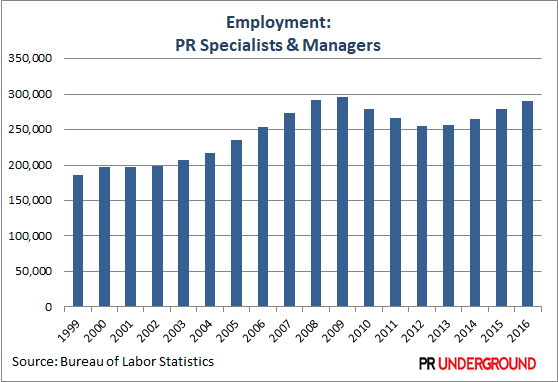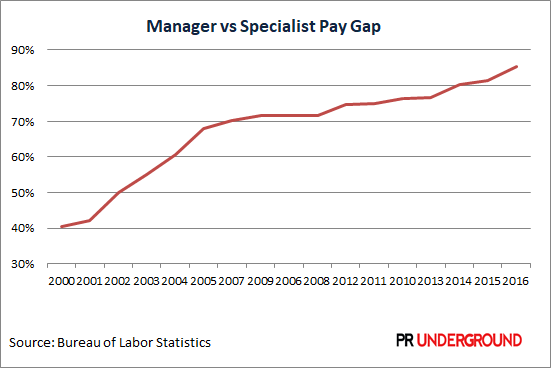 A recent analysis of 19 years of employment and wage data provided by the Bureau of Labor Statistics (BLS), and compiled by California-based news release distribution service PRunderground.com, shows an increasingly polarized PR industry.
A recent analysis of 19 years of employment and wage data provided by the Bureau of Labor Statistics (BLS), and compiled by California-based news release distribution service PRunderground.com, shows an increasingly polarized PR industry.
Overall, employment numbers show the PR industry is gaining strength.
With four years of consecutive gains in the number of jobs, the industry is back on track.
The industry added 36,110 new jobs over a period of five years and is nearing its historical peak employment levels.
This upbeat employment trend is consistent with the growth in earnings, as seen by PR firms at both national and global levels.
According to a study published by the Holmes Report, the global PR industry saw an increase of more than seven percent in 2016.
While locally, U.S. public relations companies saw a five percent increase in year-over-year growth.
PR Industry Recovery
Despite solid job gains the past few years, the PR industry recovery is years behind the broader U.S. economy.
The latest numbers from the BLS for 2016 show the PR industry is still 5,000 jobs behind peak levels, while the U.S. economy saw the recovery of all jobs lost during the financial crisis in 2014.

While PR employment gains are uneven across the U.S., some states are experiencing explosive growth. Still, others lost more than a quarter.
Some Win While Others Lose
Places such as Washington, D.C. and Maryland are in a league of their own. Both have seen a fourfold increase in the number of PR jobs compared to 1999.
Meanwhile, Texas, Massachusetts, Hawaii, and North Dakota saw their local PR industry size more than double.
However, some states are under-performing compared to the national average, and have seen their local industry size shrink.
Wisconsin lost 41 percent of its PR jobs, while Connecticut lost 25 percent, compared to 1999.
This is surprising considering both these states have overall strong economies.
Other states seeing the number of PR jobs decrease during the past 19 years are: West Virginia (-18 percent), South Carolina (-17 percent), and Indiana (-5 percent).
Some PR Jobs Experiencing a Major Shift
The explosive growth of PR jobs in D.C. and Maryland seems to be happening due to a major shift in the lobbying practice.
Trade organizations and business groups now rely more on PR firms to influence public opinion and legislators rather than traditional lobbying firms.
Lobbying takes place at every level of public government (e.g., federal, state, county, and municipal level).
And though many other places have benefited from this trend, D.C. and Maryland are in the unique position to benefit most.
PR industry employment in the D.C. metro area has been explosive, while federal lobbyists are experiencing the opposite.
In 1999, there were twice as many federal lobbyists as PR professionals in the D.C. area. And now there are twice as many PR professionals as there are lobbyists.
As part of this trend, D.C. has become a major hub for global PR firms. Of the 10 largest PR firms in the world, nine have offices in Washington.
Salaries Vary Wildly
Salaries in D.C. are among the highest in the nation.
In the D.C. area, a PR specialist makes $93,700 per year on average.
This earns the Capital City third place among the nation’s top paying areas for PR specialists.
Only PR specialists in the Silicon Valley earn more than their peers in D.C.
Pay in the industry has become polarized, as well. There’s a huge difference in pay and pay growth at many different levels.
Geography is one of them.
PR pros in San Francisco, San Jose, and D.C. receive twice as much pay as their peers in Oklahoma City and Pittsburgh.
Even when accounting for the local cost of living, there’s still an enormous pay gap between many cities across the country.
For example, a PR specialist in Providence, RI, earns $20,000 more per year on average than their peers in Albany, NY, though both areas have similar living costs.
PR specialists in Dallas earn an average of $10,000 more per year than those in Atlanta, though the cost of living in Dallas is slightly lower than Atlanta.
Executive Pay Gap Widens
Another sign of polarization comes from executive pay, which has shown a disproportionally higher increase compared to PR staff pay.

Consider this: PR managers receive on average 40 percent higher pay than staff members in the early 2000s.
Since that time, the gap has increased to 85 percent.
And the pay difference is now more than double, with no sign of this trend reversing any time soon.
After the 2014 financial crisis, salary growth for staff members barely rose with annual growth of only 0.09 percent when adjusted for inflation.
This was not the case for PR managers. Their salaries grew by a rate of 1.06 percent (adjusted for inflation). Albeit, pay growth for this segment is slower than before the crisis.
Even among PR specialists, wage growth has been uneven.
Companies are rewarding senior members of the team.
But for staffers just starting out, represented by the 10 and 25 percent income percentiles, they have seen a decline in income.
Add to this surging college debt and higher rent, and people who are just getting their start in the PR industry have a much more challenging time getting by during their first years of employment.
Execs Must Address Salary Issue
The erosion of real incomes for entry-level PR jobs seems counter-intuitive given the results of a survey by the Homes Report.
Executives at major PR firms said their biggest challenge is recruiting staff and growing teams.
But the potential low salary issue for entry-level jobs seems to have gone unaddressed.
Overall, the study shows strength in PR industry growth.
And by the time the BLS publishes its next set of data, it’s likely the PR industry will have recovered all the jobs lost during the financial crisis.
However, this may not be evenly felt across all employment levels and in all corners of the country.